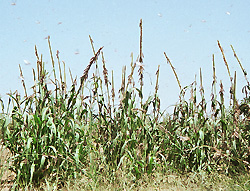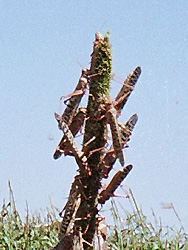| Period: 19 May 2004 - 12 December 2004. Country: Burkina Faso |
|
(1) Study on the Livelihood System of Agropastoralists in the Sahel |
| ISHIMOTO Yudai (Division of African Area Studies) |
| Key Words: The Sahel, Multiple Livelihoods, Kel Tmasheq, Risk Management, Desert Locusts |
 |
| Desert locusts eating panicles and leaves of pearl millet |
 |
|
Close-up photograph of desert locusts |
(2) In the Sahel area, which adjoins the Sahara Desert to the south, the annual precipitation is very low, ranging from 150 mm to 500 mm. The amount and distribution of the rainfall is unstable, fluctuating drastically year by year. It is not rare for the annual precipitation to be less than 300 mm, the minimum requisite for drought resistant pearl millet.
The objective of this study is to clarify how agropastoralists cope with these severe climate conditions in the Sahel and how they maintain their livelihood. I conducted a field study in a Kel Tamasheq village in northeast Burkina Faso.
Multiple activities, including agricultural production, animal husbandry, wild plant gathering and wage labor away from the village, are observed. These activities are cooperatively practiced within the residential unit, which also constitutes the unit of consumption activity.
(3)
From May 19, 2004 to December 12, 2004, I conducted my field research in a Kel Tamasheq village in Oudalan Province, northeast Burkina Faso. While I was doing the research, swarms of desert locusts invaded the northern part of Burkina Faso. This happened immediately before the harvest of agricultural products in 2004, and consequently, agricultural production was seriously damaged. People had to cope with this serious damage caused by the insect attacks. I studied the level of damage in food production and strategies to cope with the food shortage.
- I examined the productions of pearl millet in six fields in 2004, and compared the figures with the average for 2002 and 2003. The production levels of each field in 2004 were 0%, 10.6%, 10.9%, 11.0%, 11.5% and 13.4% respectively of the average for 2002 and 2003. This means the damage was devastating.
- To make up for the damage caused by the locusts, people increased their gathering as well as cash-earning activities, selling livestock and working as wage workers.
They gathered poaceous weed grains and tubers of Nymphaea sp. which provided energy. The gathering of poaceous weeds grains is performed every year. With the arrival of the desert locusts in 2004, because the ripening period of these grains was earlier than the crops, there was no negative influence and no insect damage. The tuber of Nymphaea sp. is used not merely as human food but also as forage for livestock. The gathering of the tubers was performed frequently in 2004, because the growth of pasture was also unsatisfactory, paralleling the decrease of crop yields.
Goats and sheep were sold to buy food, and people left the village to look for wage labor. There were two types of wage labor: day labor in a nearby goldmine, and labor in the Ivory Coast for more than six months. Although cash income is indispensable even in normal years, it became even more important in 2004.
Based on these research results, I will analyze mechanisms by the agropastoral Kel Tamasheq in the Sahel for the management of disaster risks such as locust attacks.
|


 21st Century COE Program
-Aiming for COE of Integrated Area Studies-
21st Century COE Program
-Aiming for COE of Integrated Area Studies-